A guide to Long-Term Customer Loyalty in E-commerce
We probably all have heard old-age mantras such as the “Customer is king” or “Customer is always right.” Both might seem outdated and probably not the advice you were hoping for when clicking on this article. Yet, they both carry an important truth that all businesses, big or small, online or offline, need to be customer-centered.
Naturally, reaching out to potential customers should be your marketing strategy's main focus. However, as your sales increase, your focus should shift to building long-term loyalty. A solid base of loyal customers is vital to a successful e-commerce business. With each additional purchase, the customer's lifetime value and the return on marketing investment increase.
How to make a customer come back? How to take advantage of their first interaction with your online store? How to build and maintain a long-term customer relationship despite the stiff competition? We have compiled an ultimate guide to explain the customer lifecycle and its mechanics, how to convert a first-time buyer into a returning customer, the best tools for building and maintaining the relationship, and examples of top e-commerce loyalty programs.
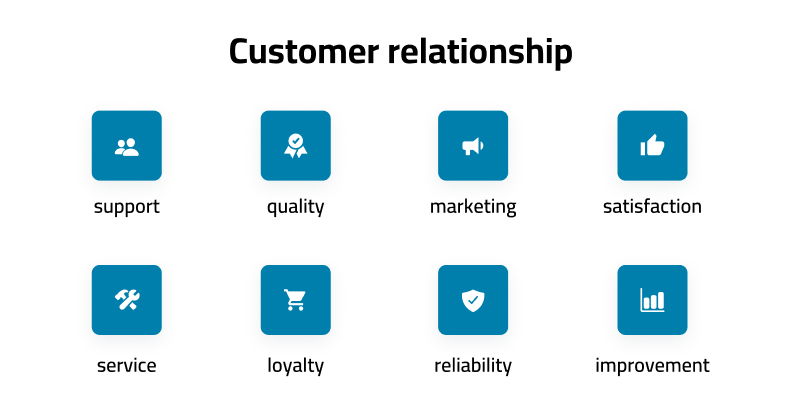
First steps into building customer loyalty
Understand the customer journey
What is the secret behind an effective loyalty marketing strategy? Well, first of all, it is important to understand all the stages of the customer journey and the challenges they imply. Ecommerce businesses that build digital marketing strategies around Customer Lifecycle Management are more efficient at converting unique customers into regulars.
Reach out to your customers
Secondly, try to understand the psychology behind customer loyalty. Despite the solely professional context, think of it as building any other long-term relationship. It takes time, consistency, and commitment. Make them feel special through personalized offers. Show them that your brand shares their values and offers the attributes of the lifestyle they aspire to have. Earn their trust through reliance and dedicated support service before and after the sale.
Be relevant & consistent
Finally, keep in mind that relevance is key. And that applies to the brand’s identity and what it offers. Conceiving a product that perfectly fits the customer’s needs is not enough, especially in a highly competitive ecommerce market. The character of your brand should be represented through its products, customer service, visual identity, structure, and values. Yet, remember that as the market and trends change, the buyers do too. The generations shift, and with them do the communication style and the media. To stay relevant, you should consistently strive to evolve with your customer base and constantly upgrade your strategies.
One of the most recent trends that came about as a response to changing customer habits and values is shoppertainment. Learn more about this trend and why it’s so successful via our article - What is shoppertainment and why you should care.
Stay sharp
Beware of your competitors - they will surely try to shift the loyalty inertia you have established over time with your buyers. So always stay on your toes and capitalize on the trust you have earned and the customer data you have collected over time; those are your true assets!
A successful conversion is the result of a great first impression. When purchasing, the customer gambles on the promise made by the e-commerce business. Do not let them down!
What is Customer Lifecycle Management?
Since the 1850s, the marketing philosophy has continuously evolved, focusing first on production, then on selling the product, and finally shifting direction and developing strategies addressing customer needs. Today, customer-centric marketing has been a norm for the past three decades.
The customer's lifetime starts at the first brand touchpoint and continues through making the purchase decision until, hopefully, becoming a regular. Therefore, a successful online business should strategically analyze the user’s behavior, adapt marketing efforts to each potential buyer, then nurture the relationship and create a loyal customer base.
The initial model of customer lifetime was first established in the late 1890s under the acronym AIDA - Awareness, Interest, Desire, Action. Over time, with experience, trial and error, brand loyalty has been added as the ultimate stage of the brand-customer relationship.
Therefore, the modern model of customer lifetime includes five stages: Reach, Acquisition, Conversion, Retention, and Loyalty. This article will briefly cover the first three and focus on the last two steps.
Reach
In this initial stage of the customer lifecycle, potential new customers become aware of your brand and its products. It is all about reaching your target group and capturing their attention.
Common marketing strategies are: targeted advertisements and social media marketing. Search Engine Optimization (SEO) is another highly efficient advertising technique. Its main advantage is organically presenting the product or service as a solution to the customer’s research. Be mindful of the buyer persona and adjust the target group of your advertisements accordingly!
Acquisition
This stage of the customer journey is also called consideration. The potential customer already knows about your offer. Now it is the time to persuade them to purchase the service or product. At this stage, they will browse your online store or social media profile and potentially reach out for additional information. Therefore, providing them with a prompt and complete response is vital.
While creating content for your e-commerce store, present the products in a flattering yet realistic way. Include close-ups of details and additional features, and do not fail to include that information in the description. This will allow the customer to make an informed decision, optimize the number of returns and exchanges, and avoid unnecessary disappointment in the later stages of the customer journey.
As mentioned before, the quality of your products needs to be complemented with a top-notch customer support to provide a fully satisfactory experience and secure the deal. Aim to optimize the conversion rate.
Conversion

Finally, the prospect becomes a buyer. Your online business has just earned another customer. Congratulations! Yet, it is hardly time to rest on your laurels. Ensure everything goes smoothly, from order confirmation through delivery and the potential return or exchange process. Providing satisfactory after-sales service is the cornerstone of customer retention and loyalty.
Retention
This is the decisive moment where the one-time purchase can become a long-term relationship leading to repeat purchases and building consumer loyalty. However, retaining customers can be tricky, especially in online shopping, where changing the provider does not require much additional effort, and physical limitations such as geographical proximity do not apply.
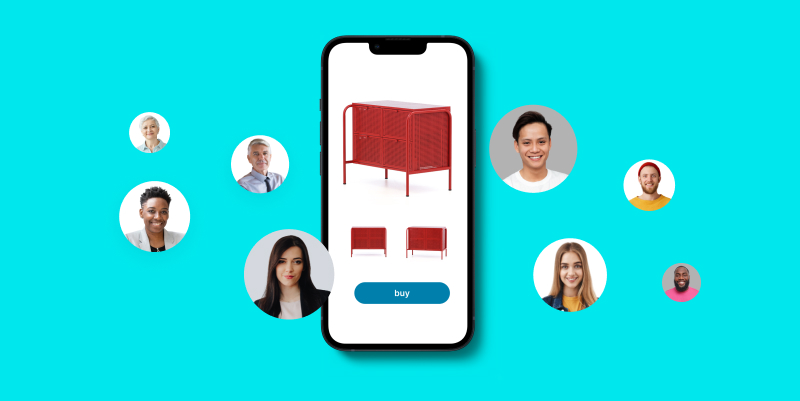
However, with a proper strategy, you can ensure customer retention and therefore increase lifetime customer value! How? Mainly through “aftercare.” After all the effort and attention preceding the purchase, the customer still needs to feel valued and cared for. Additionally, remember that managing existing customers' retention is easier than converting new ones.
Loyalty
The final stage of the customer journey. The holy grail of your marketing department. Loyalty is a key factor in online businesses' long-term success. Yet, the work is not over. Engage with your returning customers to nurture the relationship. Invite them to leave reviews and encourage referrals. Offer exclusive personalized perks by putting in place a loyalty program.
Word of mouth is the most effective form of advertisement, hence, the power of influencer marketing. Try to extend brand loyalty to your customer’s friends and family. Capitalize on your returning customer base and let them become the brand ambassadors among their community. Rewarding the customers to recommend your products, share your posts and scout your prospects can save you hundreds of dollars on customer acquisition costs.
On the other side, remember that loyalty is not set in stone once acquired. First, you need to consistently stir the customers’ interest and have them engage with your brand. Loyalty programs are an excellent tool to achieve that goal.
Also, keep an eye on your competitors and their marketing strategies. Examine what works for them and offer better benefits or complementary services.
The relationship between the brand and its customers, although sometimes relying on emotional responses, remains solely transactional. In the case of e-commerce companies nowadays, the customer usually pays for more than just a functional product but the whole package of factors contributing to their overall satisfactory experience. This may include the price, speedy delivery, free returns, attention and care of your customer support team, the feeling of being pampered and offered a unique proposal and the prestige linked to the brand or a lifestyle they aspire to achieve.
With the rise of competition in e-commerce businesses, updating your strategies and evolving with the market and customers is important. Loyalty is based on relevance and does not like stagnation.
The Customer Cycle Management
Now that we have covered the five customer journey stages let’s talk about CLM or Customer Lifecycle Management. This can save you a lot of resources and optimize your marketing efforts. CLM tracks and analyzes data for each customer lifecycle stage and behavior. The goal here is to evaluate your business’ performance at different times.
Sales Funnel
Sales Funnel visually represents your customer’s lifecycle from prospect to purchasing customer. Although it is not as detailed as a customer journey map, it can be a good starting point.

Customer Journey Map
A CJM, or Customer Journey Map is a visual overview of the customer experience and behaviors from the first interaction (when they learn about your brand) until the end (your goal). You should prepare a different map for each buyer persona.
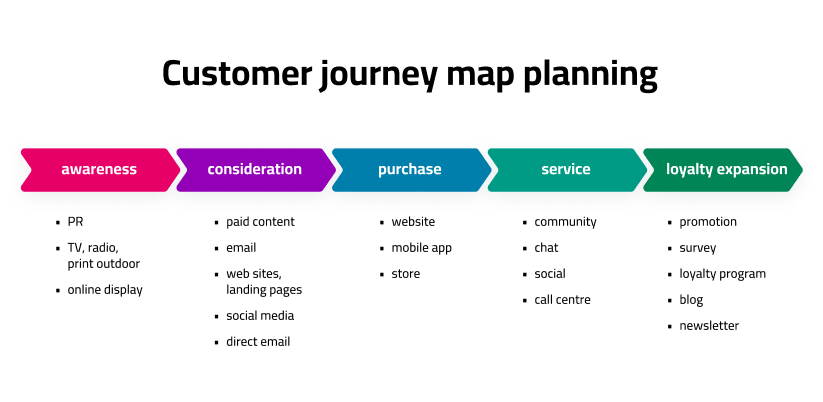
Start with some research. Asking customers for feedback should give you an idea of their common dislikes, encountered problems, and how they interacted with the company. This will show you what can be improved. If customers ask the same questions, identify the gap and try filing it in.
After initial customer feedback analysis, select one or two of the most typical buyer personas and track their journey. Identify all the actual touch points (the moments where the customer interacts with your brand or that can influence their opinion). Use tools like Google Analytics to verify which channels give you the most traffic. Remember to use UTM codes to measure the performance of your campaigns.
You can now create a Customer Journey Map with all the gathered information. Identify important milestones. These will be the stops on the journey to your goal. Next, map the customer behavior and the emotions you wish to arouse at different stages. Ensure that all the needs are met, find the gaps and the pain points, and focus on filing these in. To meet customer expectations, you need to identify them first.
The Customer Journey Map should be regularly updated as your customer base evolves. For an e-commerce business, Artificial Intelligence and automation can be tremendously helpful in analyzing customer behaviors. Customer data-driven reports improve the user experience at all customer journey stages.
Enough for the theory. Let’s explore different strategies!
Repeat purchases are the main factors increasing customer lifetime value. However, there are many ways to improve ecommerce customer loyalty.
To establish a long-term relationship, identify your customers' needs and wants and make them feel appreciated. This is the golden rule that applies regardless of your brand’s domain.
We can distinguish three types of customer loyalty:
- Repeat - the customer preferentially orders from your store; the main goal of customer retention
- Referral - recommends your e-commerce store or your products
- Identity - identifies with your brand
Here are some ways online businesses can increase customer satisfaction and build a loyal customer base.
Ensure stellar Customer Experience
Customer satisfaction is vital for ecommerce customer retention. As much as 61% of people declare they would choose the competitor's online store after just one bad shopping experience. Furthermore, over a third of survey respondents said nothing could compensate for a bad customer service experience. As you can see, the stakes are high. With the exponential growth of the e-commerce market, customer expectations keep rising.

As online shoppers compare the offers and prizes of e-commerce stores, exceptional CX is truly the factor that can make or break the deal. So turn it into your competitive advantage!
Even before making their first purchase, new customers are already influenced by the brand’s communication style. Provide quality and detailed product descriptions and photos in your online store to help them make an informed decision. Ensure the delivery, returns, and exchanges policies are clear and easy to find. Be available to answer customer questions pre-purchase and post-sale. Let your staff members test the products to ensure they thoroughly know every aspect of your offer.
Once the customer has placed the order, remember to thank them for their purchase and regularly update them on its status. Polish the visual and sensory aspects of the packaging and put in a “Thank you” note listing your social media handles and a unique discount code for their next purchase. It is a great way to make them feel appreciated! A discount code also increases their chances of choosing the same retailer and eventually becoming loyal customers. Multiple purchases tend to increase average order value.
Upload answers to frequently asked questions on your website so your staff can focus on responding to more complex inquiries and resolving them more efficiently.
Follow up, ask for feedback to keep them engaged with your brand, and collect the data for your marketing strategies!
Next to relevance and consistency, transparency is another cornerstone of customer loyalty. Mishaps will inevitably happen. To err is human!
Apologize in advance, and offer a solution and compensation. Customers are usually more comprehensive when they feel taken care of.
E-mail communication
Online stores require customers to provide personal information such as e-mail addresses. Use this precious data to your advantage and directly target the right audience!

Start with choosing a style of communication adapted to your public. Remember to use an engaging, helpful, and professional tone.
Cover all the basics, including confirmation and tracking information, follow-ups, and customer feedback inquiry e-mails. It is also a good idea to send a message reminding the customer about the product still waiting in the cart of your online store!
Your e-mails can include reviews from other users or the press, your brand’s recent achievements, and personnel recommendations. Regularly inform customers about upcoming sales and exclusive offers, and provide discount codes for newsletter subscribers. This way, more people will feel motivated to open the e-mail instead of ignoring it!
Your newsletter should provide the subscriber with additional value, like free expert advice or blogs, examples of recipes and tutorials, and outfit inspirations. You can also use e-mails to show your company's “human” side, present your team members, and show the backstage of your work.
It seems like a lot? Consider investing in technology! Automated e-mail campaigns are a must for an ecommerce business. Also, regularly update your contact list to delete customers who never open the newsletter to avoid additional costs!
Provide a personalized experience.
Before making the purchase, your customer had probably browsed through your product selection or had clicked on an advertisement or a direct link. Use this information to offer them what you already know they like! Invest in retargeting ads and cross-selling to provide personalized experiences and effectively address customer expectations. You can also prepare a gift or discount for customers’ birthdays!
Once again, we strongly encourage you to look into automation solutions to help you build customer loyalty and generate more long-term revenue.
Engage your community!
Engaging customers through a social media platform is another great marketing strategy for ecommerce brands! So how to build communities and gain loyal customers through your brand’s channels?
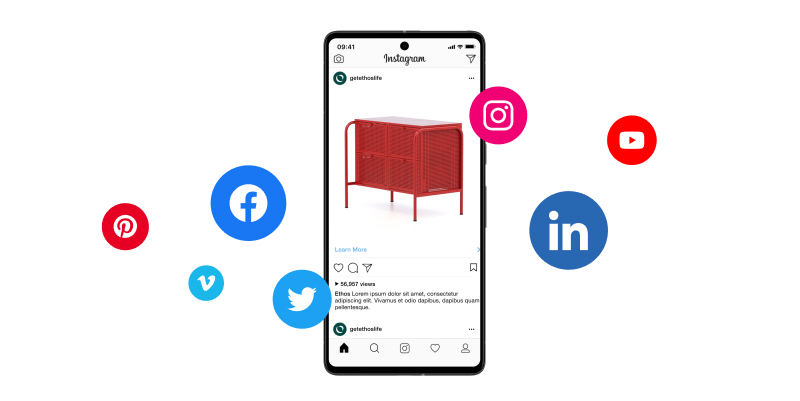
Create content! You HAVE to post regularly to grow your following. Keep in mind that reels tend to do better on Instagram than static posts. Your Instagram, TikTok, or Pinterest grid is the 2023 equivalent of a business card and should appeal to potential customers.
Conversely, use stories to engage with your community daily. Post polls, quizzes, and Q&As. Offer an exclusive insight into the backstage and the team’s day-to-day operations. Aim to build trust and create a personal bond with the brand. Storytelling is an amazing tool for building the brand’s identity, especially through Instagram stories!
Do not forget about the power of User Generated Content! Invite followers to tag the brand and repost their reels and stories. Reposting customers’ reviews helps induce trust.
Interact with customers as often as possible, reply to their comments, animate the discussion, or at least like their messages.
Instagram and Facebook have an automatic response feature that is worth looking into!
Implement a referral program
Never underestimate the marketing power of word of mouth! Consider rewarding loyal customers when the person they refer makes a first purchase. Referral programs help retain customers and extend loyalty to their close ones.
You can also ask your followers to tag friends in the comments and share your giveaway posts to increase their chances of winning!

Last but not least, customer loyalty programs
“Customer loyalty” most often evokes ecommerce loyalty programs. This is a highly popular and effective solution to score more repeat customers. Online businesses offer various types of rewards programs for their most loyal customers.
Some ecommerce programs reward customers with points for each purchase, then offer to exchange the points for gifts, discounts, or other perks, such as free shipping. Others encourage the customers to write reviews or create content for the brand to unlock advantages, reward High-Value Customers with vouchers if they spend enough annually, or unlock privileges for Subscribing Members. Finally, tiered programs offer special benefits to loyalty program members only.
Here are some examples of different ecommerce loyalty programs.
Tarte
Tarte is a cruelty-free American cosmetics company sold in U.S. department stores such as Macy’s and internationally in Sephora.

Tarte offers 500 bonus points for joining their loyal customer base. The points can be exchanged for discounts or rewards of choice. Furthermore, the member’s status and privileges grow with their point score!
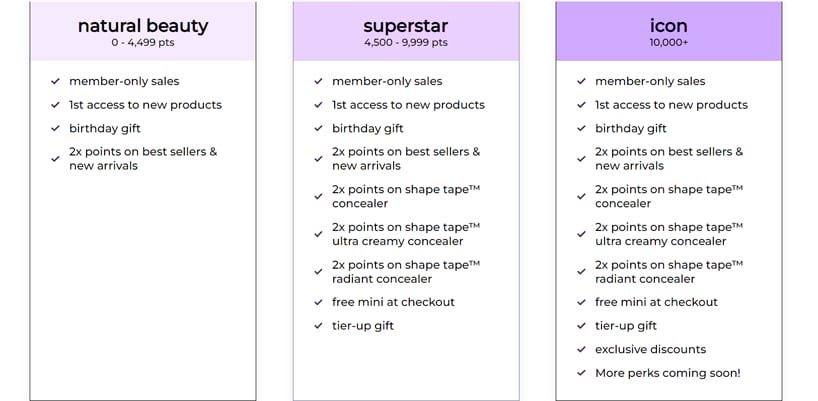
Amazon Prime
The classic that revolutionized the market and became the gold standard of Pay2play loyalty programs. The biggest ecommerce company launched its customer loyalty program in 2005.

The biggest plus of Amazon Prime is its simplicity. For a monthly or annual subscription, prime members can access same-day, one-day, or two-day delivery options, a streaming platform, exclusive deals, photo storage, Prime Reading, Prime Gaming, and save on prescription medication.

Amazon offers a 30-day free trial, affordable plans for students and customers Qualified for Government Assistance, and a $ 5$ referral credit.
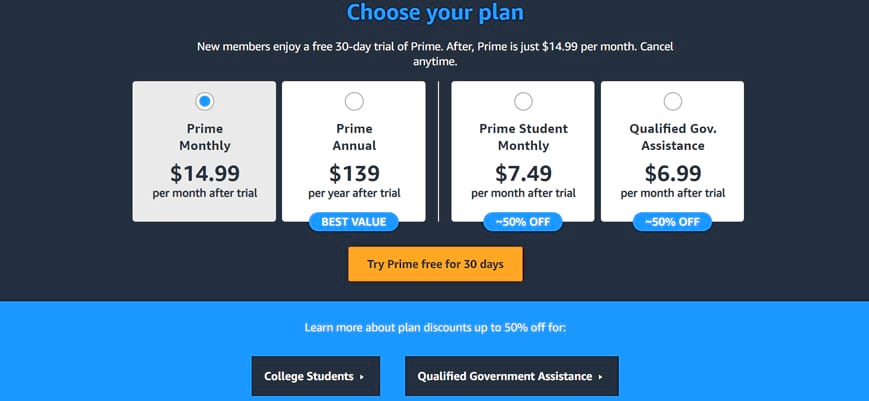
Nike
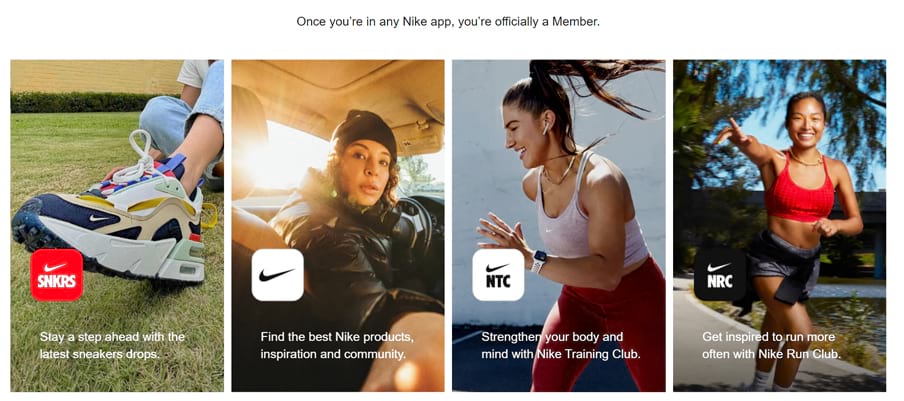
Nike offers a Member Only program called Nike Plus. The user can easily sign up for free on the company’s website or via any of their apps to unlock the following advantages:
- Gear available exclusively to members
- Same-day delivery
- Extended shopping hours in some of Nike’s shops
- Expert guidance and workout programs
- Access to the co-creation service and personalized experiences

Final Thoughts
Increasing customer loyalty in ecommerce is crucial to your brand’s long-term success. However, creating a lasting relationship with your customer base may seem challenging and requires a thorough market study and optimization of your marketing efforts.
Keep in mind that to earn customers’ trust and keep the interest of your loyal customer base, you must continuously question and upgrade your strategies to adapt to the dynamically shifting market.
There is no one-fits-all solution, but commitment and consistency are the keys to long-lasting customer relationships. Trust the process!
We hope you found this guide inspiring!
Articles you may also like

Product photography is often one area where e-commerce businesses can spend a lot of money and time. Photoshoots take up way ...

We are excited to announce we have a new addition to the ORBITVU USA team - B3K Digital! This exclusive dealer partnership w...

Product visualization is vital in almost every business, especially e-commerce, where 93% of consumers consider visual appear...







